 |
|

|
 |
TABLE of CONTENTS
 |
Snowstorms keep crews busy, draw praise from motorists |
By Anne Meyer
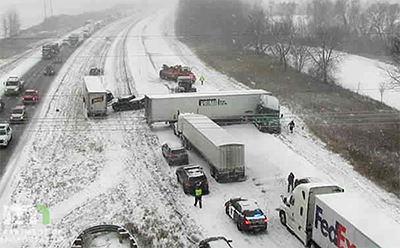
MnDOT traffic cameras and cameras mounted in snowplows captured some of the road conditions during the Dec. 10 snowstorm that blanketed southern Minnesota.
Above, a jackknifed semi blocked traffic for several hours on Interstate 35 near Faribault. Below, a District 6 plow camera shows the near-whiteout conditions that drivers faced during the storm.
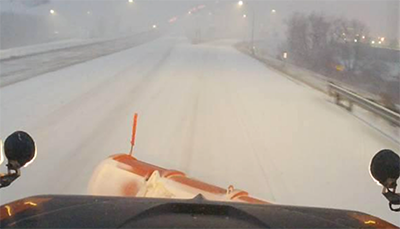
|
This winter season started off dry and warm, but in December all corners of the state experienced plowable snowfall. Northern Minnesota received the first hit, when a sizeable storm left behind several inches to more than a foot of snow along the North Shore Dec. 4. A few days later, the next snowstorm had an impact in western and southern Minnesota. And then areas of the Twin Cities received up to 20 inches of fresh snow when a powerful system impacted much of the state Dec. 10.
Heavy snow and strong winds created difficult driving conditions, but MnDOT crews took on each challenge and had highways back in the clear quickly, often within 24 hours of the start of the snowstorm. That hard work was recognized on social media as travelers showered snowplow drivers with praise. Here are just a few of the comments:
AMAZING job @MnDOT. Drove home to Stillwater last night from a hockey tournament in Edina. At 9:30 p.m., there were big drifts on the freeways and no bare road exposed. Back to Edina this morning and the freeway was completely clear. Best work I’ve ever seen after a storm!! -Brynna T.
Shout out to the wonderful @MnDOT worker who helped these Iowans dig their car out of snow when we were stuck and even gave up his own gloves. I wish we knew your name so we could thank you properly, you saved the day! -BossyJayne
Huge shout out and thank you to all the snowplow drivers out there. To get 13-15 inches of snow and have cleared roads the next day is incredible. Well done! -Nick G.
So many thanks to all city & MnDOT crews who put in a long day/night working to keep MN safe. I had family out driving for work last night, so I’m truly grateful for the efforts! -Kit O.
| |
|

|
 |
TABLE of CONTENTS
 |
MnDOT's 'hidden utilities' - agency treats millions of gallons of wastewater each year |
By Joseph Palmersheim

The Heath Creek wastewater pond in Faribault uses sunlight to disinfect water after it has been treated onsite. These ponds are typically drained in the fall and spring and filled in the summer and winter. Photo by Neile Reider |
Neile Reider knows he is doing his job well if no one knows that MnDOT has a wastewater engineer.
"It's one of these industries where no one knows you exist until something goes wrong," he said.
Reider, based at Central Office in the Office of Maintenance, oversees MnDOT's drinking water and wastewater management efforts at MnDOT's buildings statewide. These efforts involve everything from a simple septic system to mechanical treatment plants, treating around 10 millions of gallons of water a year.
The agency treats millions of gallons of wastewater at approximately 50 sites, with the majority of treatment occurring at the rest areas along the Interstate 35, 90 and 94 corridors. These rest areas are mostly rural and isolated from water instrastructure. Facilities typically need to be within a mile of these municipal services for the connection to be cost effective.
"Water and wastewater is something no one cares about until it's backing up into your building," Reider said. "They are hidden utilities. Until they don't work, everyone is good. You expect the toilet to flush. You expect the drinking water to be safe. And rightly so, because we shouldn't have to worry."
People in the buildings are the main users of water, including use of kitchen sinks for meal prep. The second biggest use of water is for vehicle maintenance and cleaning. While many places have a bump in water usage in the summer, MnDOT has one in the winter, Reider notes, due in part to having to wash plows and other equipment for maintenance and inspection.
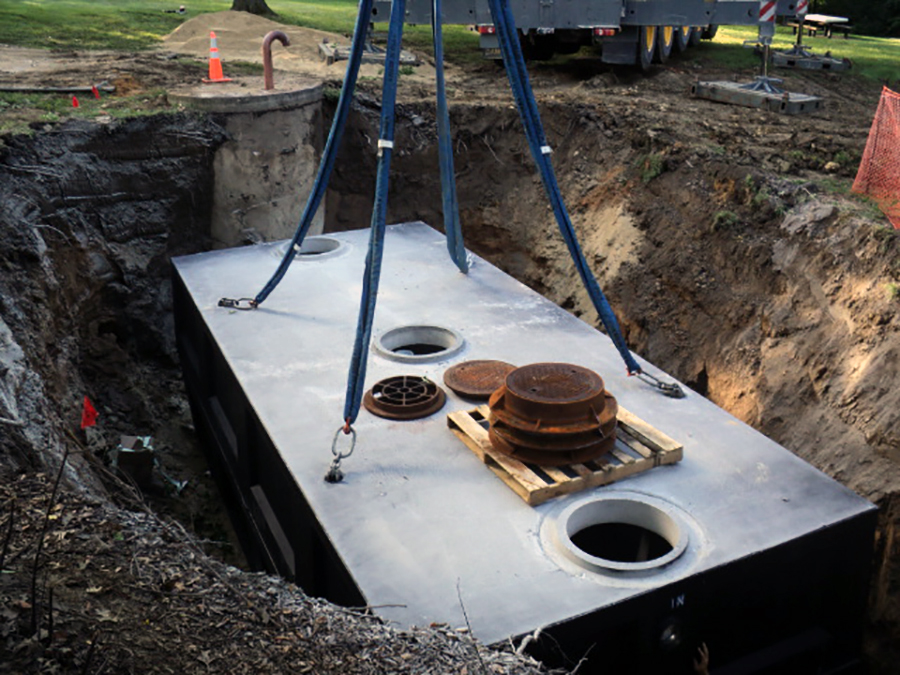
This septic tank at the Enterprise rest area off of Interstate 90 in Lewiston (District 6) filters solids from wastewater, allowing them to setting. The water is discharged into a drain field, where it eventually goes back into the water table. Photo by Neile Reider |
Other, non-human, water uses inside the building include brine production and water tanker trucks using it for dust control.
"For the most part, we treat all of our wastewater like it has human waste inside of it," Reider said. "There are settling tanks to get solids, fats, oil and debris out. Depending on the level of treatment required, we have treatment devices to help good bacteria to grow. That good bacteria will clean up the water. It eats the organics in the water. After that, we do disinfection. Sunlight does that in our pond systems. Those ponds are typically drained in the fall and spring and filled in the summer and winter. When discharge happens is weather dependent and established by our permits."
For septic systems, the soil disinfects the water by killing viruses and bacteria that will get people sick. The first three feet of soil virtually eliminates the bad virus and bacteria in the water, Reider said. The tank is there to filter solids, and then water is discharged into a drain field, where it eventually goes back into the water table.
Part of MnDOT's water use efforts seeks to prevent needing to treat water in the first place – by using less of it.
Fixture replacement has helped. Changing out old toilets from 1970s can reduce water use from five gallons per flush down to 1.28 gallons per flush. Making this change at the Enterprise Rest Area in District 6 has saved the agency more than a million gallons of water a year. Using different, hardier grasses at rest areas has helped reduce the need for irrigation, and updated equipment procedures have helped, too.
Sometimes, it's making lemonade out of metaphorical lemons.
"We have two water reuse plants still in pilot/research phase," Reider said. "In those plants, we're experimenting with taking salty discharge from plow wash water and cleaning the soap out of it. Then we're using that salty water as the source water to make brine. Brine is salty anyways.
"If the water is salty, Reider isn't. Twenty years into the wastewater management business, he still enjoys the challenges that come along with it. "I like the intersection of biology, engineering and public health," he said. "I like the fact that it makes the world a little bit better of a place, more habitable."
|
| |
|

|
 |
TABLE of CONTENTS
 |
Districts 2, 6 and Metro recognized with 2021 work zone safety awards |
By J.P. Gillach

I-35W, looking northbound from the Franklin Avenue bridge during the early stages of the 94@35W Downtown to Crosstown project, used staged construction to allow continuous flow of traffic within a restrictive environment where many neighbors live directly adjacent to the project. Photo courtesy of Ted Ulven |
Projects in District 2, District 6 and Metro District have won MnDOT’s 2021 Construction Work Zone Safety awards. The projects are recognized for outstanding work zone performance and innovation.
MnDOT’s annual Work Zone Safety Awards are sponsored by the Office of Construction and Innovative Contracting. Recipients are nominated by their peers and scored by a panel in six areas:
- Compliance to work zone traffic control standards and guidelines
- Improvements to existing traffic control plans, standards and guidelines
- Application of innovative work zone traffic controls
- Maintaining a good working relationship between project and contractor personnel
- Communications/public relations
- Accident investigation/work zone improvement
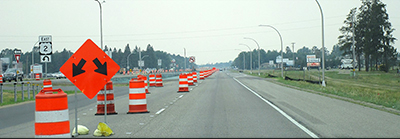
Hwy 2 looking westbound, away from Bemidji, during a later stage of the Hwy 2 Wilton to County Road 9 project. Here, the detailed staging plan allows all movements through this intersection while crews complete the project. Photo courtesy of Ted Ulven |
“The teamwork between MnDOT staff, contractors and subs, and our many internal and external partners on these projects – in putting safety first – is essential for advancing work zone safety. These awards have specific criteria, and the team effort required to meet those criteria is important to recognize and lift up,” said Nancy Daubenberger, deputy commissioner and chief engineer. “Congratulations to this year’s award winners!”
2021 marks the 33rd year of the awards. The 2021 winners are:
District 6 – I-90 bridge over-height system in Austin
The Interstate 90 bridge project replaced the 28th Street bridge over I-90 in Austin. Temporary construction falsework was required, which reduced the overhead clearance beneath the bridge. An over-height detection system was used to alert noncompliant trucks to use an exit ramp. The project team used the Office of Construction and Innovative Contracting’s extra enforcement program so State Patrol could be on site more often to enhance compliance of the over-height detection system. Local agencies were included in traffic planning efforts, and district public affairs staff kept residents and motorists informed about traffic changes.
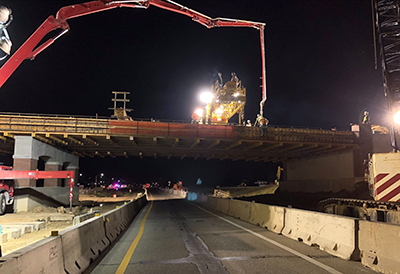
Crews pour concrete overnight as part of the I-90/28th Street bridge project in Austin. Also shown is falsework that decreased the clearance beneath the bridge. An over-height vehicle detection system was used to alert over-height vehicles that they must exit and use the interchange ramps as a detour. Photo courtesy of District 6 |
District 2 – Highway 2 Wilton to County Road 9
District 2 installed Reduced Conflict Intersections and LED lighting on Hwy 2 from CR 14 in Wilton eastward to County Road 9. The project occurred along a high-profile location of a busy corridor serving businesses, including a movie theater. The detailed traffic control sheets helped crews effectively manage traffic so it would flow well and still protect workers and motorists through all stages of construction. Temporary signing and devices allowed new construction to be opened while awaiting final striping and signing due to material supply issues.
“Traffic control was clearly a high priority on this project. It was discussed at each weekly meeting and resulted in continuous revisions to improve operations,” said Ted Ulven, work zone safety supervisor, Office of Construction and Innovative Contracting. “The public was also kept informed by way of a Facebook site for the project, and weekly updates on the project webpage.”
Metro District – I-94/35W Downtown to Crosstown project
Metro District’s “Downtown to Crosstown” project required four years of staged construction at the junction of two of Minnesota’s busiest high-speed, multi-lane roads. The project’s outstanding communication and coordination between MnDOT, contractors and the city contributed to the success a project that involved 24/7 traffic control work and maintenance. On-site communication with motorists included long-term construction information signs, portable and permanent changeable message signs with real-time information, and driver speed feedback signs. Concrete barrier was used extensively to provide positive protection for workers. An extensive public communications campaign provided timely information about traffic changes to media, and to motorists directly.
More information about the awards, including past winners, can be found here. |
| |
|

|
 |
TABLE of CONTENTS
 |
Giving a hoot: District 6 specialist honored for protecting barn owls at work site |
(Editor's note: Barn owls sometimes re-use nest sites. As such, the exact bridge is not being named in this article.)
By Joseph Palmersheim

These five fledgling barn owls nested in a District 6 bridge during summer and fall 2021. John Schmidt, District 6 transportation specialist, earned an Above and Beyond Award for his work in making sure the birds weren't disturbed by repainting work. All of the birds survived and eventually flew away in mid-October. Submitted photo |
A pair of barn owls decided to call a District 6 bridge home for part of this summer and fall.
And while crews worked on repainting one end of the truss bridge, five baby owls nested inside of a compartment on the other.
It wasn’t a matter of if they’d meet, but when.
On Oct. 5, the contractor foreman was working ahead of his crew, cleaning up bird debris, when he “heard a heck of a noise,” said John Schmidt, a transportation specialist in construction.
“He didn’t know what it was, so he stuck a camera inside the bridge gap and saw that there were five fledgling owls in there,” Schmidt said. “Owls don’t all hatch at once. They hatch according to when the female laid the egg. It can be up to a few days apart. We notified the Department of Natural Resources who in turn included the U.S. Fish and Wildlife Service. After finding out that that the DNR people were not trained in fall protection, as OSHA requires to enter this type of work environment, I told them I would handle anything they needed so they’d be happy with us doing our work and keeping track of the owls.”
The birds were in a pocket about 14 inches wide by a foot and a half deep. Schmidt estimates that when the owls hatched, they were in one compartment, but as they got bigger, they took up too much space, moved into another two. It gets pretty filled up by owls, he noted.
When crews sandblast bridges, they have to contain whatever comes off so it doesn’t contaminate the surrounding areas. This is usually done with tarps, used to build tents that keep debris inside. Crews modified the containment area around the owls so the adults could still fly in, and that the fledgling owls could eventually fly out. Plans changed so that crews would return to the area of the nest later in the project, after the birds were gone.
When the foreman found the young birds on Oct. 5, they were within a few weeks from fledging, or flying out and away. Schmidt checked in on them every few days. All the baby birds survived and flew away by Oct. 15.
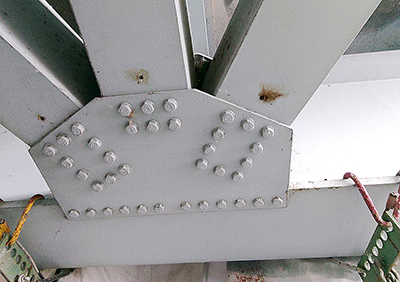
The baby owls' multi-compartment nesting area met at this juncture, and could not be seen without sticking a camera into the gap. Submitted photo |
“This nest wasn’t even there when we started preparing the safety equipment in July,” Schmidt said. “They made the nest and laid the eggs after we started the project. We weren’t disturbing them, but they didn’t like it when we got close.”
It’s not the first time that animals showed up in one of Schmidt’s projects. He’s worked on projects with crossings for Blanding’s turtles. There was the project near Red Wing where a staff member kept an eye on a local bald eagle nest to make sure the birds weren’t disturbed by pile driving. And there are animal crossings under bridges. The list goes on.
“I’m a bird guy, so that’s why I volunteered to do whatever I could do to help them,” Schmidt said. “The only other nest recorded in this area this year was actually in La Crosse and made the local TV news. They said it was extremely rare there. We opted to keep it to ourselves for the safety of dedicated birders who may have tried to access our work area to try for a look. I’d known about barn owls, but I’d never anticipated I’d deal with it here. They are just not that common in this area. It was pretty cool to run across them. It’s one more wild thing that we have had to deal with, and this one was actually interesting. We’ve got the rules we have to protect the things we have. I think it’s just fine, even if it delays our work. Fortunately, we were able to accommodate the fledging barn owls without losing valuable work days.”
For his work with the barn owls, Schmidt earned an Above and Beyond Award for demonstrating Performance Excellence and Public Service Excellence. He was nominated by Adam Wellner, construction project engineer, who noted, in part, in the award citation: “Your quick and thoughtful work balanced the needs and challenges this discovery presented and served the public well…Your experience and expertise recognized a potential challenging issue, but your efforts to involve all parties in the solution helped ensure that the project could continue without suffering a setback. Thank you!”
|
| |
|

|
 |
TABLE of CONTENTS
 |
Mary Otto named new tribal state relations training manager |

Mary Otto is MnDOT's new tribal state relations training manager Submitted photo |
Mary Otto has been appointed MnDOT’s new tribal state relations training manager in the Office of Tribal Affairs, effective Nov. 22.
In her new role, she will oversee the tribal state relations training for the State of Minnesota employees.
“The Tribal State Relations Training has impacted my life both personally and professionally,” Otto said. “It fills a gap in our history that I didn’t learn about in school and provides a clear understanding of the 11 tribal governments with which we share geography. MnDOT is so much more than roadways, and I am looking forward to learning more about the important work that everyone does from A-Z, and how I can help employees have strong and effective working relationship with tribal governments and their staff.”
Prior to MnDOT, Otto worked as tribal liaison at the Minnesota Department of Commerce and worked for the White Earth Band, of which she is a member. She lives on, and works from, the White Earth Indian Reservation (located in MnDOT’s District 4).
Otto earned a master’s degree in Tribal Governance and Administration from the University of Minnesota-Duluth and has a bachelor’s degree in Education from Minnesota State University-Moorhead. She is a mom of two, and enjoys hunting, hiking, biking, camping and family time.
She can be reached at mary.otto@state.mn.us. |
| |
|

|
 |
TABLE of CONTENTS
 |
On the Job: April D. Lucas leads agency Shared Services effort |
By Joseph Palmersheim
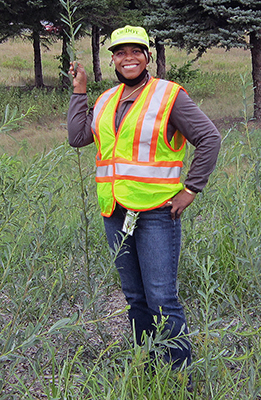
April D. Lucas holds up one of the willow living snow fence plantings at one of MnDOT's living snow fence solutions near Hwy 52 and Interstate 494 in Mendota Heights in August 2021. These plantings are maintained by Landsculpt Incorporated, a women-owned small business. Photo by Dan Gullickson |
April D. Lucas is the Shared Services director and Efficiencies manager in the Operations Division. The 15-year MnDOT employee started as an adult student, working as program specialist for the Seeds and Phoenix programs under then-director Emma Corrie, and helped to implement the first outstate Seeds and Phoenix programs at Bemidji High School in District 2.
What do you do in your current role?
I work with people throughout the state, collaborating to identify gaps and create cost-effective business solutions for the agency.
An example would be connecting the Metro District’s Advancing Transportation Equity initiative with our Blowing Snow Control Shared Service. This allowed us to deliver more than $4.5 million in snow fence projects throughout the state. With the help of the Advancing Equity team, we were able to develop a relationship with Magnum Ventures, a woman-owned Targeted Group Business, to provide the snow fence materials needed for these projects. Using MnDOT’s Negotiated Maintenance and Construction Contracting process, small businesses and TGBs will have the opportunity to quote on installing these fences. Magnum Ventures will not only supply the materials, but they will deliver the materials and provide installation guidance to maintenance crews and local small businesses installing them.
We’ve also worked with our training development specialists throughout the state to develop the process for our new CDL Shared Service.
What is Shared Services?
The Shared Services concept is an organizational approach on building efficiencies while reducing redundancies. This allows us to provide services on behalf of the entire agency. It is intended to provide relief from heavy workloads experienced by district staff.
What do you find interesting about it?
What I find most interesting is the people, both inside and outside of MnDOT. Our agency and our partners are filled with innovative solutions and the willingness to succeed. Seeing that dynamic in action is energizing to me.
What’s your favorite part about what you do?
I am always excited about what I call ‘unweaving the weave,’ which is an old MnDOT term that I have always loved! For me, this term means looking for solutions and clarity to challenges. This usually morphs into asking, ‘Who can this help and can this change become self-sustaining?’ My degree is in diverse human relations and financial management, and it is so true to who I am.
Anything else you’d like to add?
Sue Mulvihill (retired deputy commissioner and chief engineer) once told me, ‘Don’t be afraid to try everything.’ We are developing a new Shared Service to provide CDL training in-house with a pilot date for the first quarter of next year. I think my next personal adventure will be to earn my CDL. Thank you, MnDOT, for making a great career a possibility! Happy Holidays and remember, during this busy season and throughout the year, to intentionally set aside time specifically for you and your own personal self-care.
Do you or a co-worker have an interesting job to share with readers? Send us your ideas, and we’ll contact you for more information.
Recent employee profiles:
|
| |
|
| |
|



